10 Best Sculptures in Rome, Italy
Discover the top 10 sculptures in Rome, Italy full of history and culture.
Rome is not just its unique antique buildings. Its history resides not only in its architecture but also in its many sculptures all around the city.
Sculptural works of art are scattered around the Italian capital and often give unrivalled insight into what makes Rome truly unique. Head to Rome to marvel at its statues and other images to uncover its nonpareil imperial spirit.
Here are the top 10 sculptures in Rome.
(Disclaimer: Some links in this post may be affiliate links, meaning if you click on the link and make a purchase, I receive a small commission. This is at no extra cost to you and you may even receive a small discount. See disclosure for more information.)
In This Post
Top 10 Sculptures in Rome, Italy
The Pieta

One of the most famous sculptures in Rome is Pieta, a piece of Renaissance art crafted by Michelangelo and nestling in St. Peter’s Basilica in the Vatican. It is the only statue the great artist ever autographed.
The sculpture features dead Jesus held by his mother Mary after he was crucified. It reminds one of the central pillar of Christian faith, Jesus’s self-sacrifice for the sins of humanity and the possibility of forgiveness.
In order to see this sculpture in all its grandeur, you must ascend the view deck around the cathedral’s dome if visiting the Vatican. It offers one of the world’s most stunning vistas.
➡️ Read More: Hidden Gems in Italy
Sarcophagus of the Spouses
Located in the stunning National Etruscan Museum the Sarcophagus of the Spouses is one of the most significant examples of Etruscan art.
Etruscans were the people who had inhabited the area of Rome and its surroundings prior to the city’s founding. There are few traces of them apart from the unique pieces of art they left behind.
The terracotta-made 1.11m-high-1.9.m-wide Sarcophagus of the Spouses is a depiction of a married couple in the afterlife. It is distinct in that in contrast to the Greek vases depicting men-only drinking gatherings, the statue presents the Etruscan custom where men and women alike are present at a banquet, making it one of the most unique sculptures in Rome.
It was uncovered at the necropolis of Cerveteri in the 19th century and is one of the main reasons to visit not only the Etruscan Museum in Villa Giulia but also Rome and Italy in general.
Keep in mind that the sculpture seems to project a positive image of death. The wife appears to be offering perfume, and her left hand is holding a pomegranate, a fruit associated with immortality in Etruscan mythology.
Read More: Best Places to Visit in Europe in November
August of Primaporta
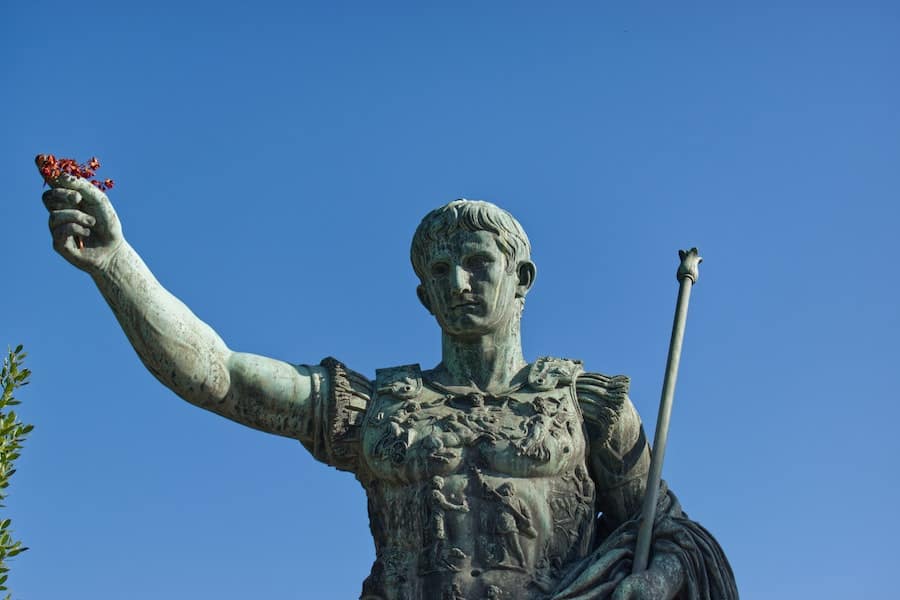
August of Primaporta is one of the most famous sculptures in Rome. The 1000kg marble image pictures Roman Empire’s first emperor, Caesar Augustus.
Not only did Augustus assemble what was to become the prototype of the future world empires but he also refashioned a formerly-brick-built Rome in marble, contributing greatly to its architectural grandeur.
Thus it is befitting to start your tour of Rome with a visit to one of his greatest sculptures in Rome.
Head to the Vatican Museum to gaze at the virile statue of Augustus, and keep in mind that his sculptures in Rome are one of the earliest use of art as a tool to spread propaganda: in this case the state’s narrative to set up its leader as a paragon of imperial virtue.
➡️ Read More: Is Rome Worth Visiting?
Roman Forum’s Vestal Virgins statues
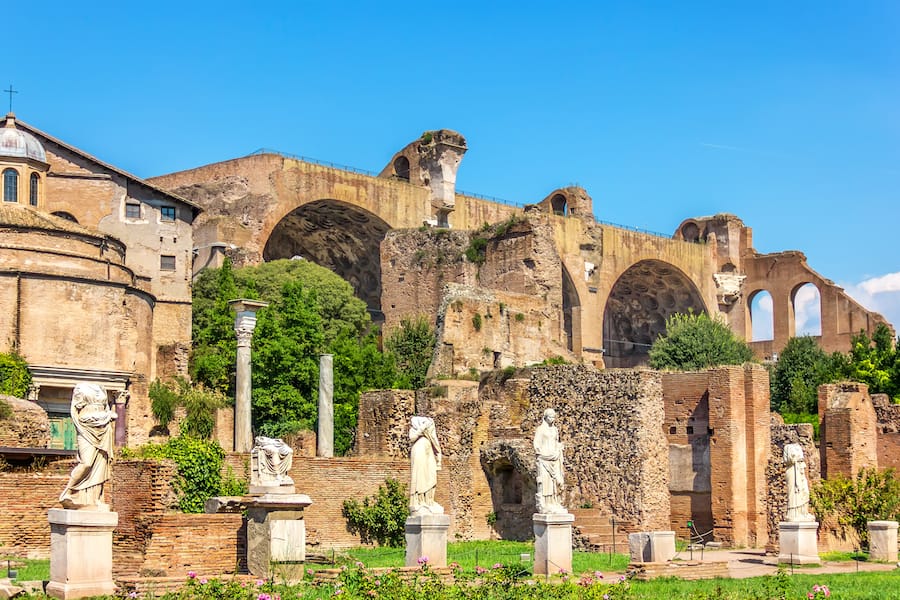
Found in the House of Vestals in one of the most ancient sites in Rome, the Roman Forum, the white marble statues of Vestal Virgins rank among the most valuable sculptures in Rome.
They were excavated in 1883 in the Roman Forum, inside the complex composed Rome’s prime architectural landmarks. Since then the statues of virgins dedicated to Vesta, a goddess, and sworn to chastity have become some of the most important sculptures in Rome.
They are an ever-present reminder of the glorious, pre-Christian polytheism of Rome, which accompanied it in its imperial rise.
You can see them on a tour of the Roman Forum, one of the best things to do in Rome. Travel to Roman Forum not just to see some of the best sculptures in Rome but also to approach other unique Roman like the temple of Saturn, Temple of Castor and Pollux, Temple of Vesta and the Temple of Venus and Roma.
Also bear in mind that the stunning Forums of Julius Caesar and Caesar Augustus are located a few hundred metres away.
Apollo of Veii
Also situated inside the Etruscan Museum in Villa Giulia, the Apollo of Veii is one of the best sculptures in Rome. The terracotta tunic-clad statue had been made by the only Etruscan artist known by name, Vulca. It was discovered in ancient Veii’s Portonaccio sanctuary. It dates back to 510-500 BC and is sculpted in the late-archaic Etruscan manner, also known as Ionic.
In the museum the statue is exhibited standing on its own, however, it had been initially part of a sculptural ensemble depicting Heracles competing with Apollo over the Ceryneaian Hind, a humongous female deer larger than a bull.
It pictured the labours of Heracles before his attaining the divine status and becoming part of the Olympic pantheon of Gods.
Head to the Etruscan Museum in Villa Giulia to see for itself this proof of strong Greek influence on Etruscan art and check out one of the most amazing sculptures in Rome.
She Wolf Sculpture
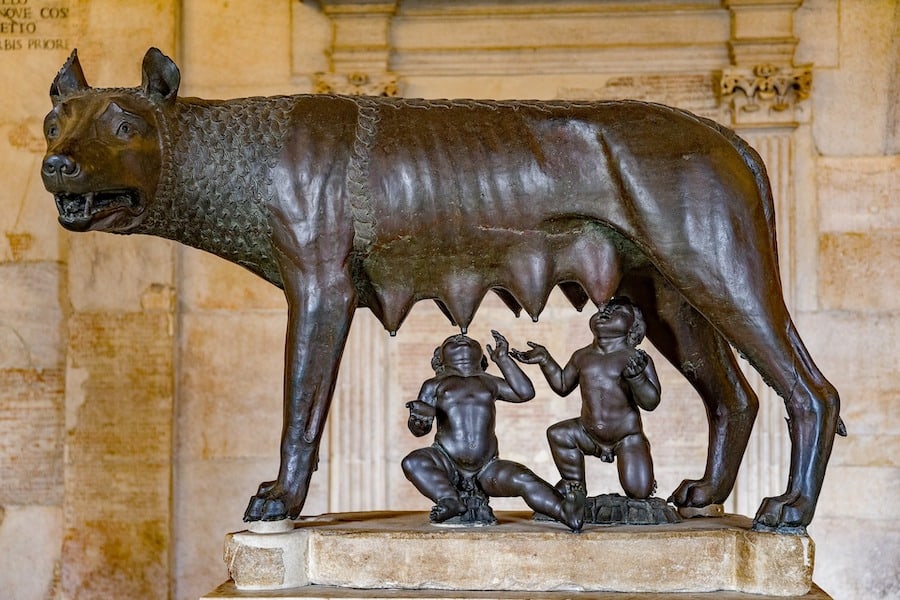
Have you heard the miraculous history of the founding of Rome? That of two brothers raised by She-Wolve that were to found the great city of Rome? If so, you will be pleasantly surprised that you can see the wolfess for yourself in the Palazzo dei Conservatori.
The bronze sculpture, one of the most iconic sculptures in Rome’s origin is debated. It may just as well be the work of ancient Etruscans or a more recent creation of 1021-1153 masters. Whatever its provenance, the bronze-cast statue has become a veritable symbol of Rome.
Make it to the Palazzo dei Conservatory, to approach the Roman past in one of the world’s most stunning pieces of art. There are many copies perched on columns and other locales all over the world.
Elephant and Obelisk
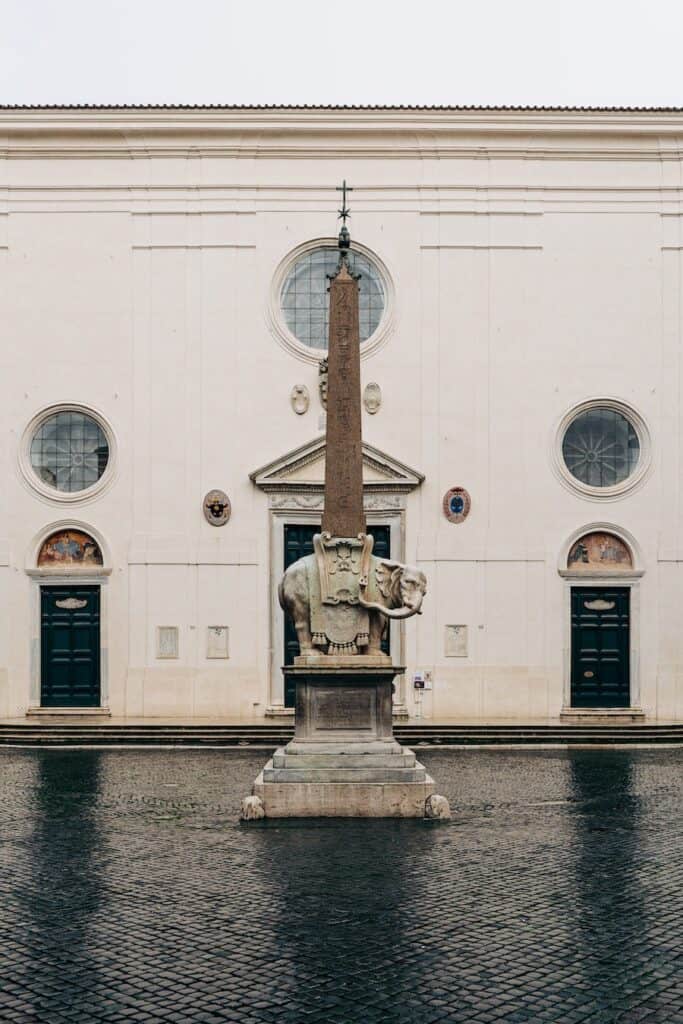
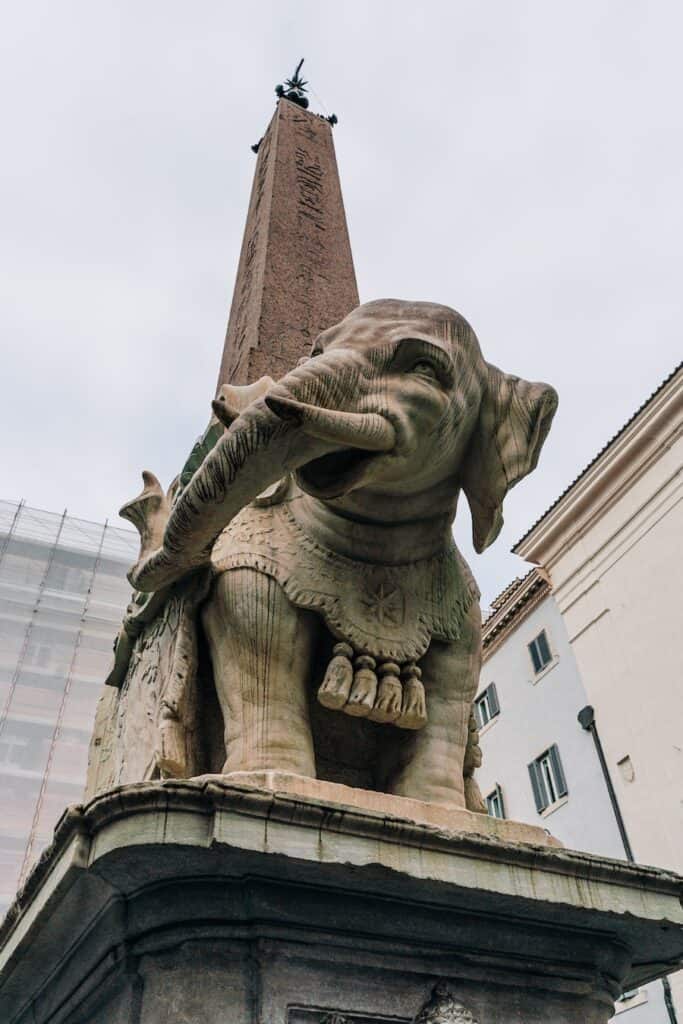
Designed by Gian Lorenzo Bernini, an Italian artist, Elephant and Obelisk is a poignant sculpture of a small elephant bearing an obelisk. Inaugurated in 1667 it beautifies Rome’s Piazza Della Minerva and sits next to the beauteous Santa Maria Sopra Minerva.
What makes it one of the most popular sculptures in Rome is not just the touching elephantine figure, but also a fascinating story of its origin. It had been brought from Egypt where it had been prettifying the temple of Isis, an Egyptian goddess. It is said to have been commissioned by Pharaoh Apries about 580 BC, making it one of the oldest sculptures in Rome.
Centaur of Vulci
Whereas the Apollo sculpture bears witness to strong Greek impact on the Etruscan art-making, the Centaur of Vulci housed in the same museum shows that it was not just the Hellenic culture that affected the ancient Etruscans.
Unearthed in Vulci, close to Viterbo, it traces its past to the period when Etruscan art was under strong Oriental influence. It was part of a private burial site in the necropolis of Poggio Maremma, now part of Vulci Archeological Park.
Dating back to 590-580BC, it represents a centaur, a half-horse-half-man. It features a trimmed beard, three-braided hair and a puny chest with no tail. Head to the Etruscan museum to have a look at this millennia-old stud.
Trevi Fountain

The baroque Trevi Fountain, named after the area it is located in, is one of Rome’s most famous tourist sites. It is not just a one-of-its-kind 26m-high-49.15m-wide fountain, but it is also a site of some of the best sculptures in Rome.
Initially, supposed to have featured Agrippa, a close ally of Augustus who helped him attain supreme power and divine status; and Diana, known to Romans as Trivia, the fountain came to be adorned with allegorical depictions you can see today.
In the center you can find Oceanus, erect under a triumphal act, with a chariot drawn by two horses, a reminder of a mercurial nature of the sea: sometimes calm, sometimes savage.
The fountain also features the sculpture of Abundance, one of the most beloved sculptures in Roome. It holds a cornucopia with an overthrown vase at her feet. Above her is the bas-relief of the legendary general Agrippa.
Head to the fountain to take a selfie, and photos of the allegorical images, which are among of the most favourite sculptures in Rome.
Discobolus
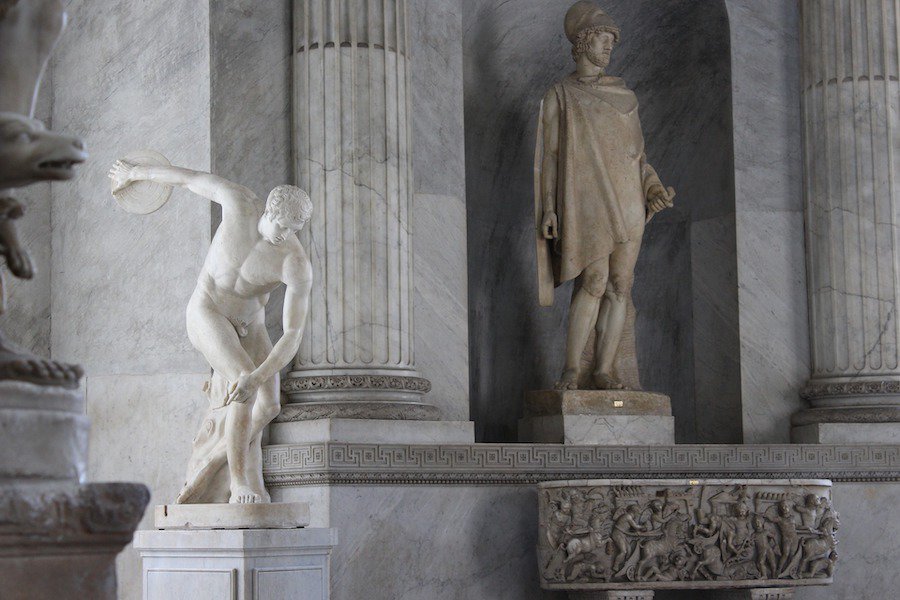
Housed by the National Museum of Rome, the Discobolus, a disc-thrower, is one of the most prized sculptures in Rome. It serves as the perfect representation of athleticism, capturing the moment of utmost focus before the release of the disc.
A copy of Myron, a Greek sculptor’s work, is known for its perfect proportion and shows the progress of Classical sculpture from the Archaic tradition.
When visiting the National Museum of Rome for a glimpse of the disc-thrower, note that it’s being here is the result of one of the darkest pages in European history. Purchased by Adolf Hitler it would have stayed in Germany had it not been for the German defeat at the hands of the Allied forces.
The Discobolus, one of Rome’s most valued sculptures in Rome was repatriated in 1948 and since then has become a veritable tourist magnet, drawing in thousands of tourists to just see it.
Head to Rome not only to uncover its architectural marvels from antiquity to the present but also the wealth of magnificent sculptures in Rome. Note that whereas some of them are displayed in the city’s multiple museums, many of them can be seen outside, blending into a unique aesthetic mélange with the city’s beautiful facades, creating a truly one-of-its-kind cityscape.
Like this post? Pin “10 Best Sculptures in Rome” for later!
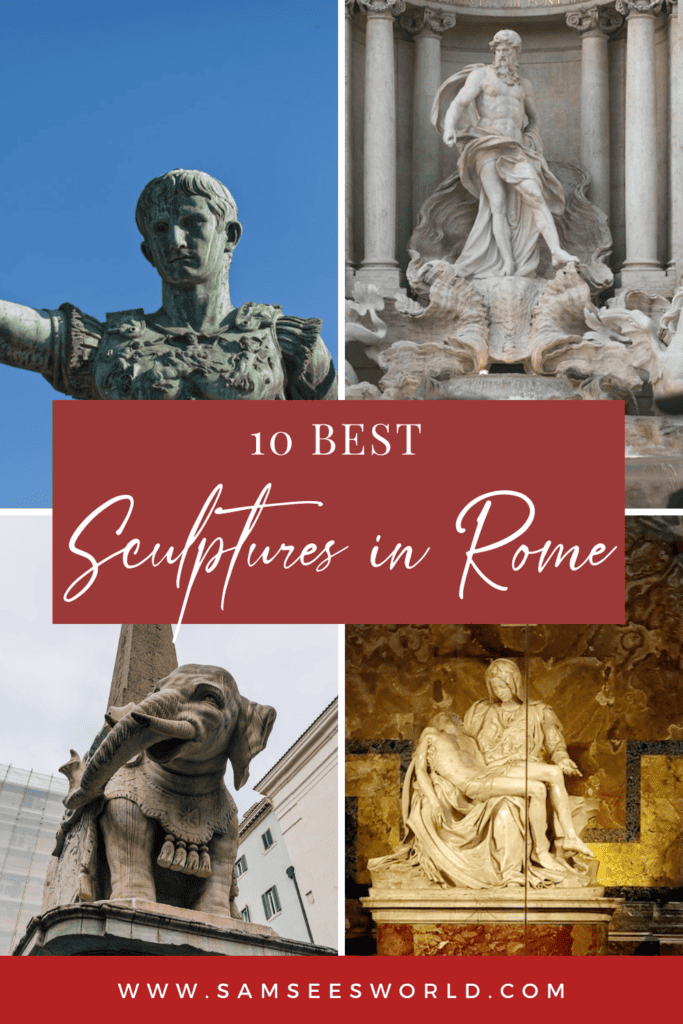
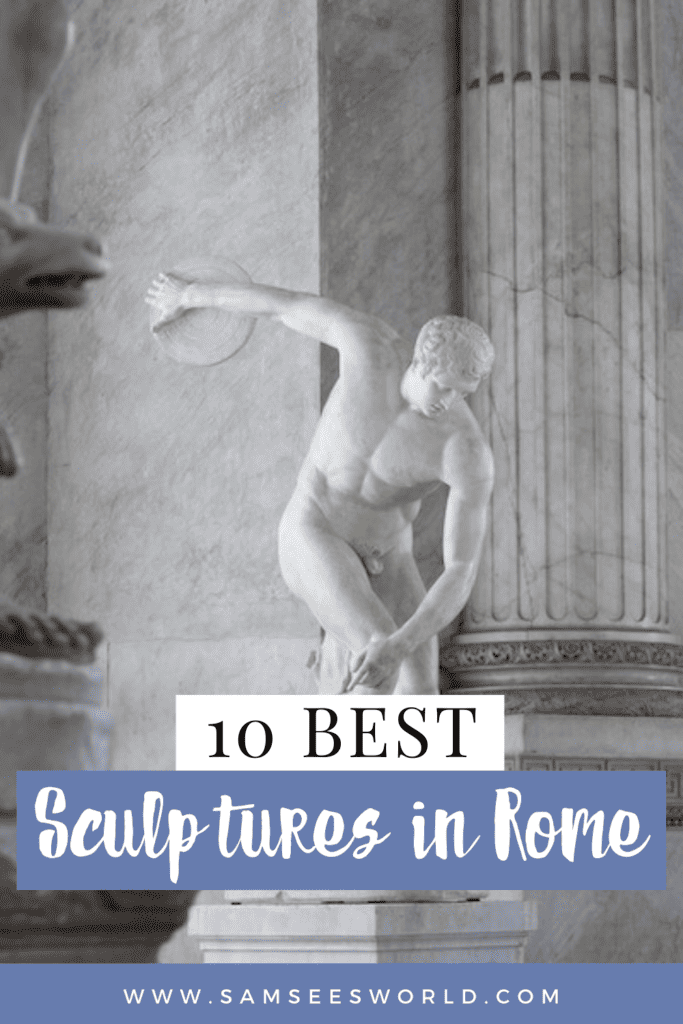
Love,
SSW